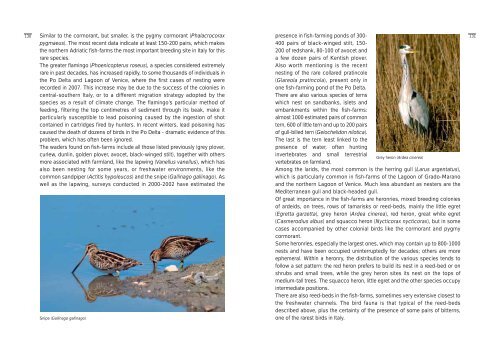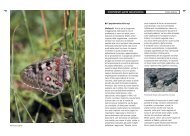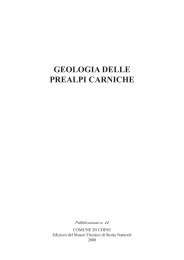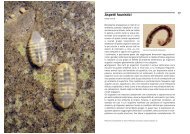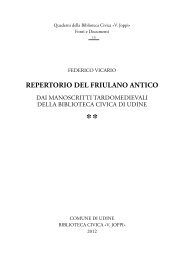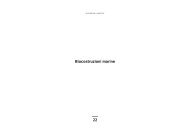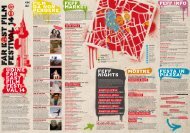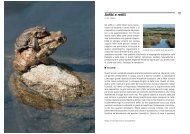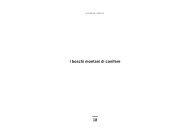Terrestrial invertebrates - Udine Cultura
Terrestrial invertebrates - Udine Cultura
Terrestrial invertebrates - Udine Cultura
You also want an ePaper? Increase the reach of your titles
YUMPU automatically turns print PDFs into web optimized ePapers that Google loves.
130<br />
Similar to the cormorant, but smaller, is the pygmy cormorant (Phalacrocorax<br />
pygmaeus). The most recent data indicate at least 150-200 pairs, which makes<br />
the northern Adriatic fish-farms the most important breeding site in Italy for this<br />
rare species.<br />
The greater flamingo (Phoenicopterus roseus), a species considered extremely<br />
rare in past decades, has increased rapidly, to some thousands of individuals in<br />
the Po Delta and Lagoon of Venice, where the first cases of nesting were<br />
recorded in 2007. This increase may be due to the success of the colonies in<br />
central-southern Italy, or to a different migration strategy adopted by the<br />
species as a result of climate change. The flamingo’s particular method of<br />
feeding, filtering the top centimetres of sediment through its beak, make it<br />
particularly susceptible to lead poisoning caused by the ingestion of shot<br />
contained in cartridges fired by hunters. In recent winters, lead poisoning has<br />
caused the death of dozens of birds in the Po Delta - dramatic evidence of this<br />
problem, which has often been ignored.<br />
The waders found on fish-farms include all those listed previously (grey plover,<br />
curlew, dunlin, golden plover, avocet, black-winged stilt), together with others<br />
more associated with farmland, like the lapwing (Vanellus vanellus), which has<br />
also been nesting for some years, or freshwater environments, like the<br />
common sandpiper (Actitis hypoleucos) and the snipe (Gallinago gallinago). As<br />
well as the lapwing, surveys conducted in 2000-2002 have estimated the<br />
Snipe (Gallinago gallinago)<br />
presence in fish-farming ponds of 300-<br />
400 pairs of black-winged stilt, 150-<br />
200 of redshank, 80-100 of avocet and<br />
a few dozen pairs of Kentish plover.<br />
Also worth mentioning is the recent<br />
nesting of the rare collared pratincole<br />
(Glareola pratincola), present only in<br />
one fish-farming pond of the Po Delta.<br />
There are also various species of terns<br />
which nest on sandbanks, islets and<br />
embankments within the fish-farms:<br />
almost 1000 estimated pairs of common<br />
tern, 600 of little tern and up to 200 pairs<br />
of gull-billed tern (Gelochelidon nilotica).<br />
The last is the tern least linked to the<br />
presence of water, often hunting<br />
<strong>invertebrates</strong> and small terrestrial<br />
Grey heron (Ardea cinerea)<br />
vertebrates on farmland.<br />
Among the larids, the most common is the herring gull (Larus argentatus),<br />
which is particularly common in fish-farms of the Lagoon of Grado-Marano<br />
and the northern Lagoon of Venice. Much less abundant as nesters are the<br />
Mediterranean gull and black-headed gull.<br />
Of great importance in the fish-farms are heronries, mixed breeding colonies<br />
of ardeids, on trees, rows of tamarisks or reed-beds, mainly the little egret<br />
(Egretta garzetta), grey heron (Ardea cinerea), red heron, great white egret<br />
(Casmerodius albus) and squacco heron (Nycticorax nycticorax), but in some<br />
cases accompanied by other colonial birds like the cormorant and pygmy<br />
cormorant.<br />
Some heronries, especially the largest ones, which may contain up to 800-1000<br />
nests and have been occupied uninterruptedly for decades; others are more<br />
ephemeral. Within a heronry, the distribution of the various species tends to<br />
follow a set pattern: the red heron prefers to build its nest in a reed-bed or on<br />
shrubs and small trees, while the grey heron sites its nest on the tops of<br />
medium-tall trees. The squacco heron, little egret and the other species occupy<br />
intermediate positions.<br />
There are also reed-beds in the fish-farms, sometimes very extensive closest to<br />
the freshwater channels. The bird fauna is that typical of the reed-beds<br />
described above, plus the certainty of the presence of some pairs of bitterns,<br />
one of the rarest birds in Italy.<br />
131


